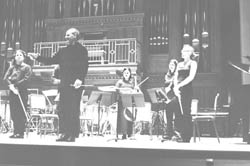|
News
|
|
|
Perspectives
|
|
|
Arts
|
|
|
Sports
|
|
|
Other
|
|

Contemporary Music Ensemble Ends Term In Style
by Kari Wethington

|
|
Out With A Bang: The Contemporary Music Ensemble played Finney Chapel Tuesday. (photo by Claire Sturm) |
Tuesday in Finney Chapel the Contemporary Music Ensemble played its third and final concert of the semester, led by Associate Professor of conducting Timothy Weiss and Guest Conductor Mitchell Arnold. The performance brought together three engaging pieces that successfully explored the expanses of contemporary music through a diverse and challenging medley of instrumentations and themes.
The sensational opener was American composer George Crumb's 1970 masterpiece Ancient Voices of Children. Many of Crumb's compositions were heavily influenced by the surrealist Spanish poet Federico Garc’a Lorca and this piece was no exception; it was a cycle of songs based on texts written by Lorca relating the story of a little boy looking for his voice.
The composition presented an interesting array of percussion, as well as unconventional voice exercises and chanting. Throughout, one heard the intermittent, sparse, always haunting sounds of the mezzo-soprano and girl soprano voices, oboe, mandolin, harp, amplified piano, toy piano and three percussion parts.
Lorraine Manz, professor of singing, mastered the mezzo-soprano voice Crumb called for and began the piece by singing into an amplified piano, creating a minimal but penetrating tone. The percussion shortly joined humming, then chanting delicately in the background. When the harpist joined in, also chanting, the mood was purely atmospheric: delicate but poignant.
Throughout the five movements of the song, tempos shifted, moods lifted and flexed and experimentation was plentiful. During part II, "Gacela of the Flight," Manz uttered Lorca's poetry through a cardboard tube as the piano and harp were plucked in a staggering rhythm. "I have lost myself in the sea many times as I lost myself in the heart of certain children," was her grave message. Parts III and IV saw the composition become increasingly frenetic and then creep back down to a whisper leaving the eerie melody of a lone mandolin.
Part V, "Ballad of the Little Square," fused Manz's voice with that of girl soprano Katie Dauphin of the Oberlin Choristers, directed by Katherine Plank. Though Dauphin's delicate and intriguing voice could be heard replying to Manz's in earlier movements, she finally came on stage to join Manz. The finale was as quiet and enigmatic as the beginning, but left the listener with a brilliant impression.
Guest Conductor Mitchell Arnold, a visiting assistant professor of conducting, led a small arrangement of piano, strings and winds in performing the concert's second composition, Dreaming Fire, Tasting Rain, a piece written in 1995 by Anna Rubin, an assistant professor of composition. The piece brought together the flute, clarinet, violin, viola, cello and piano in a short but powerful piece.
As quoted on Oberlin Online, the title of Dreaming Fire, Tasting Rain appeals to Rubin "because of the logically contradictory - but emotionally consistent - confluence of the two images of fire and water." This idea was consistent throughout the piece; while it had its share of surprises, the periods of intensity were balanced with overall lightness. Each instrument was well highlighted in this performance, making the sound a clear and memorable one.
The final performance of the evening was Alban Berg's Chamber Concerto for Piano, Violin and Winds, Op. 8, which was delivered by an ensemble consisting of piano, violi, and thirteen winds and featured professor of pianoforte Monique Duphil and professor of violin Marilyn McDonald as soloists. While awaiting the delayed arrival of one of the ensemble's bassoon players, conductor Timothy Weiss explained which technicalities of the 40-minute piece contributed to its points of rhythmic chaos.
The Chamber Concerto was magnificent; it had so many twists and turns, the audience never knew what to expect, yet every high followed by a deep, ravenous low felt completely natural. The depth added by the bassoon, contrabassoon, horns and the triumphant but mellow flute and oboe parts was especially impressive. The piano and violin were also prominent and contributed significantly to the divine confusion that brought the delivery of this work to such a high level.
Tuesday night's concert was outstanding in every respect, bringing together a variety of contemporary music in a brilliant exhibition that served as a graceful close to the semester.
Copyright © 2000, The Oberlin Review.
Volume 129, Number 12, December 15, 2000
Contact us with your comments and suggestions.